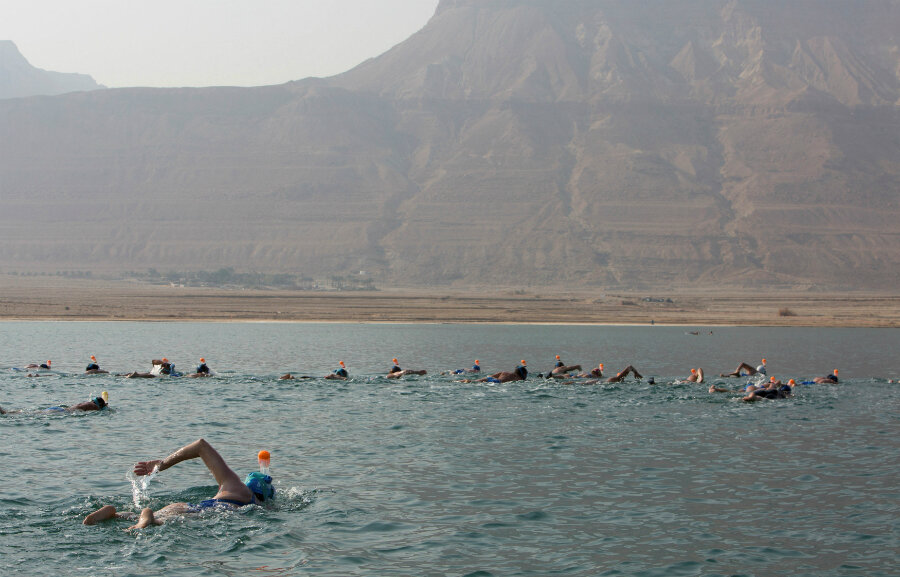Why the Dead Sea is getting saltier – and shallower
The Dead Sea may soon live up to its name, environmentalists say.
The world’s most historic salt lake has been shrinking by about three feet every year, according to environmentalist group EcoPeace Middle East. Excessive tourism is taking its toll on the Dead Sea, the group warns, and inflow has slowed to a trickle. The lake’s water, which is increasingly extracted for use in cosmetic and "therapeutic" products, simply isn’t being replaced.
If the Dead Sea really is drying up, it joins many other dwindling reservoirs across the globe. Many, such as the Ogallala aquifer in the Midwestern United States, are victims of poor water management. Others may suffer the effects of climate change, such as drought and increased salinity. But there are plans that could save the Dead Sea – and maybe the other lakes, too.
The Dead Sea is nestled at the lowest point on our planet – about 1,400 feet below sea level – and wedged between Israel, Jordan, and the West Bank. It is also among the oldest natural attractions in the world, drawing Mediterranean travelers to its shores for thousands of years. The lake’s unusually high density allows swimmers to float with ease. Its hypersaline waters are renowned for their "healing powers" – under the Roman king Herod I, the Dead Sea became one of the world's first spa resorts.
Today, cosmetic companies extract mineral water from the Dead Sea to make shampoos and skincare products. As those products become increasingly popular, extraction becomes more prevalent.
Theoretically, that shouldn’t be a problem. Traditionally, the Dead Sea has been replenished by other natural sources, such as the Jordan River basin.
But about 50 years ago, neighboring countries diverted many of those inflow sources back to cities as water supply. The region’s dry-heat makes it difficult to the lake to restore itself, and lost water increases the relative salinity of the lake.
“Far and away the biggest cause of the rapid disappearance of the Dead Sea is the lack of water coming into it from its traditional sources – the Jordan River,” EcoPeace Middle East wrote in a statement. “While much of this water is being used by the Israelis, Jordanians, and Palestinians for basic domestic consumption, most goes towards highly subsidised and inefficient agriculture.”
Meanwhile, tourism has driven development in the region. New hotels and attractions are beginning to block off the remaining inflow sources, replacing lost water with sewage instead. Just like Yellowstone National Park, the Dead Sea is being "loved to death."
The Christian Science Monitor’s Todd Wilkinson reported:
Critics say the Park Service – beleaguered by deteriorating roads and buildings, threats to natural resources, overwhelming public use, and the potential effects of climate change – is ill-equipped to steward its 411 parks, cultural sites, and historical monuments forward another 100 years. They believe the sacred national park experience that so many people journey to see has already vanished at some of the most popular destinations and will only get worse without a serious infusion of money and a rededication to preservation.
And while the Dead Sea itself doesn’t host any wildlife – an unusually high 34 percent salinity means most forms of marine life can’t survive in the lake – a complete dry-up would hurt local tourism and the environment considerably.
“Despite the lack of wildlife in the Dead Sea itself, the region around it is blessed with unique flora and fauna, including endangered species such as ibex, leopards, and hyrax,” EcoPeace wrote in a statement. “The wetlands surrounding the Sea support several species, such as the indigenous ‘Dead Sea Sparrow,’ and serve as important resting and breeding sites for millions of migratory birds crossing between Europe and Africa each year.”
Limiting tourist development, the environmental group says, would be a major step toward preserving the Dead Sea. Smarter water management could also play a role – to that end, surrounding nations could learn a thing or two from Mexico City.
For years, Mexico’s capital has pumped billions of gallons of groundwater from the valley it sits on. This rapid consumption has actually caused parts of the city to sink by several inches per year. In the slums, residents are delivered a finite supply of water by truck. Elsewhere, taps simply dry up.
That’s why local environmental organizations, such as Isla Urbana, have begun building rainwater catchment and purification systems. These systems can provide six months of clean drinking water to 1,000 families at a time, and recycling rainwater can help curb flooding.
In the meantime, officials have already begun taking action in the Dead Sea region. Last year, Israel and Jordan signed a $900 million deal to build a canal from the Red Sea to the Dead Sea. It’s still unclear what the actual environmental impact would look like, but the canal could at least theoretically pump water to both nations while also replenishing the Dead Sea with 300 million cubic meters of water annually.






